Dampproofing or waterproofing? Which is required and where? These are questions I hear often in our industry, and I figured our Winter issue on waterproofing and roofing was one of the best places to address the confusion. With the help of our director emeritus, John A. D’Annunzio, we’ve broken it down as simply as possible.
Waterproofing is used to prevent moisture from penetrating sub- or above-grade walls and slabs. This can be achieved with a variety of materials in two separate systems:
1. Dampproofing
2. Waterproofing
Dampproofing is a system designed merely to resist the flow of moisture in a gaseous state. It can only be used in below-grade walls that are not subjected to hydrostatic pressure. These types of systems resist the flow of water vapor through a building component. They are most commonly used to prevent or reduce migration of water by diffusion.
Waterproofing systems are designed to resist hydrostatic pressure that is extended by moisture in a liquid state. Waterproofing systems typically use reinforcement membranes that can be adhered to the substrate in a variety of application methods. Typical application methods include hot application with heated asphalt, cold applications with solvent-based adhesives, torch applications or self-adhered membrane sheets.
The decision to use waterproofing or dampproofing systems can be determined by three criteria. First, if hydrostatic pressure is present, a waterproofing system is required. A waterproofing system is also required for framed-slab constructions. For retaining walls or slabs-on-grade, the question is whether a slight leak risk is acceptable. If the answer is yes, then dampproofing may be considered. If the answer is no, then waterproofing is required.
Dampproofing Methods
If it is determined that dampproofing is an acceptable method, it can be applied on the following components: slabs on ground, foundation walls and retaining walls with finish bonded to the wall. Dampproofing should not be applied on concrete walls that have a cavity and brick facing because water can flow down these walls and discharge through weep holes into interior surfaces.
We hope you enjoy this issue, where we look at many different forms of waterproofing and roofing techniques.





